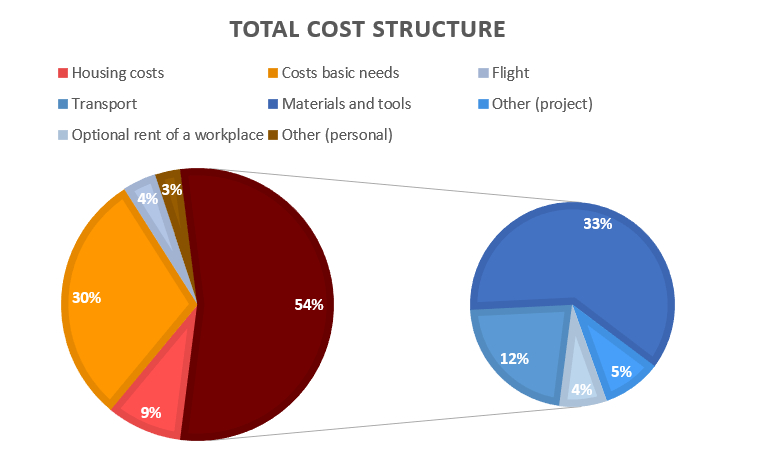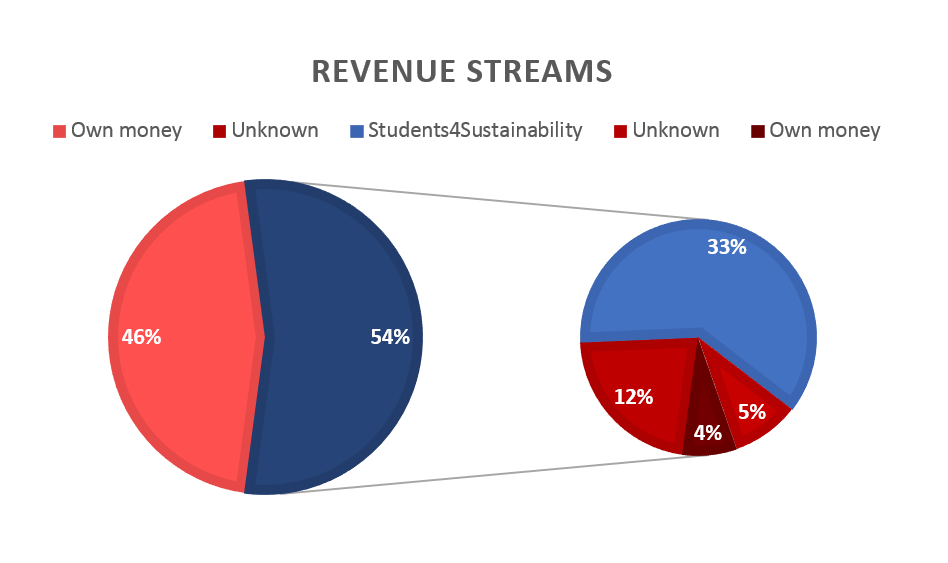To carry out the project successfully, different types of costs are included.
We made a rough estimation of these costs:
Personal costs
Housing : 450
Costs basic needs (such as food, running water, electricity etc.) : 1500
Flight costs : 180
Other : 150
Project costs
Transport : 600
Materials and tools : 1650
Optional rent of a workplace : 200
Other : 250
All the costs are calculated for the entire time span of the project, three months. The personal costs are presented as the total of costs for the three of us. All the costs are in Euros.
The only fixed costs in this scheme are that of the flight and housing. The other costs can vary and are thus estimations.
The costs for food are calculated with a standardized food consumption of western food types by NUMBEO (2015), a database of user contributed data providing current and timely information on world living conditions. They state that the minimum amount of money monthly spend on food is 1.330,93 Moroccan Dirham per person, which is about 121 euros. This number multiplied by 3 makes about €360. Again multiplied by 3 (as we’re staying there three months) gets us to a sum of money of €1080,-. However, the amount of money we estimate to spend on basic needs is determined at €1500,-, because we expect to also have to pay for running water, electricity etc.
The costs for transport to the test locations are calculated with a tariff of €0,37 per kilometre. (This is the lowest tariff of the tariffs in the four big cities, given by NUMBEO (2015)). Assuming that during our stay we will travel to those test locations maximal on twenty days, and the average travelled distance for a retour will be 80 kilometres, the overall costs for transport will be around €600,-.

In the figure above, the division of the total cost structure is portrayed. The costs can be divided in personal costs and costs for the project. The costs of the project will play the biggest role in the cost structure. These costs can on its turn be divided in costs for materials and tools, which will be the most, transport to the test locations, the possible rent of a workplace and other (unexpected) costs, for example presents to support contact with our customer segments or charges for social media such as a website to give updates on our project.
These costs create different revenue streams that are further explained below:
An important aspect of the revenue streams is fundraising. As we are building and iterating prototypes, money is needed to collect all the necessary materials and tools.
The organisation Students 4 Sustainability is investing in our project to provide money for the materials and tools. Students 4 Sustainability is an organisation that invests in sustainable, pioneering, projects in developing countries with the use of sustainable technology.
They set up a list of criteria whether or not they will sponsor a project, the list is as follows:
- The project is/will be a project done by students from the TU Delft that takes place in a developing country.
- The project is innovative. For S4S this means that the project develops a prototype or add value to an already consisting product (by doing research e.g.).
- The project corresponds to the people-planet-profit ideology.
- The project is interesting for other TU Delft students.
- A local entrepreneur/partner is involved in the project.
Our project meets all the criteria.
In the following figures the cost structure is linked to the revenue streams. Housing costs, costs for basic needs, the flight and other personal costs will be paid with our own money. The project costs, which takes 54% of the total amount, are paid by different parties. Students 4 Sustainability will provide all the materials and tools. Other costs such as presents for our customer segments will be taken care of by ourselves.
Sources
NUMBEO (2015). Food Prices in Morocco. Retrieved 30 October 2015, from http://www.numbeo.com/food-prices/country_result.jsp?country=Morocco
